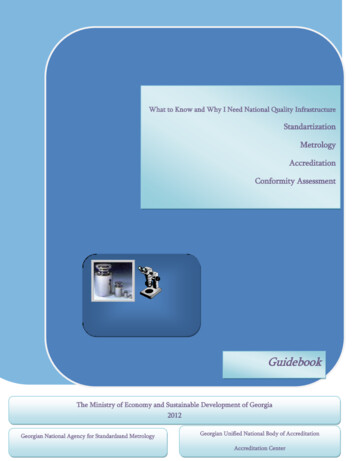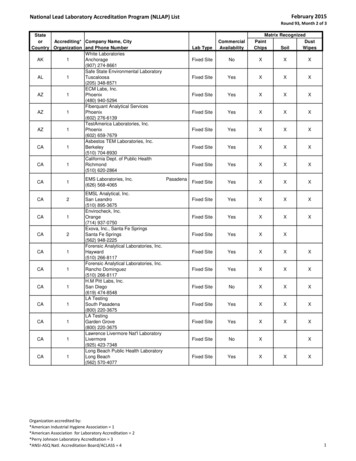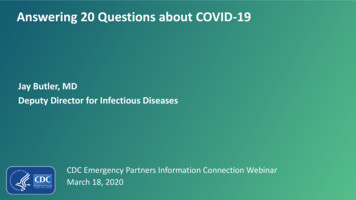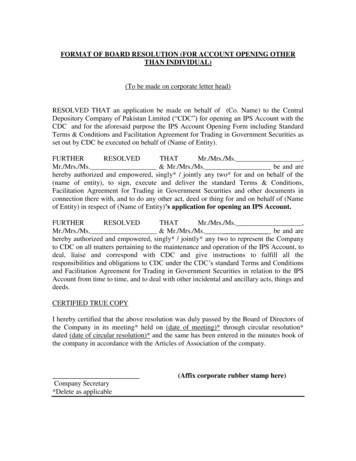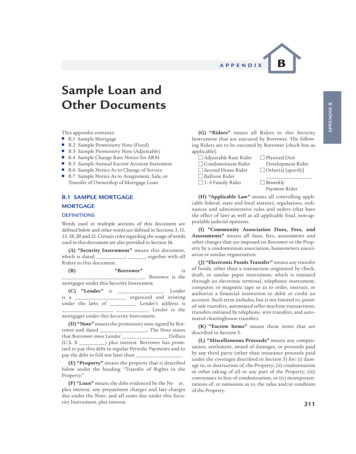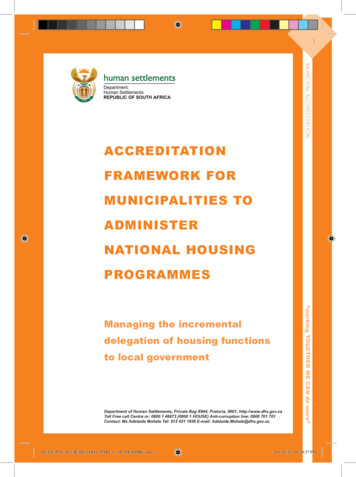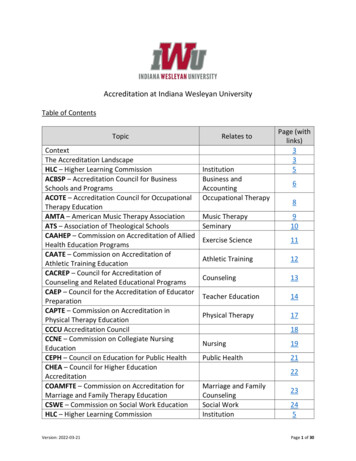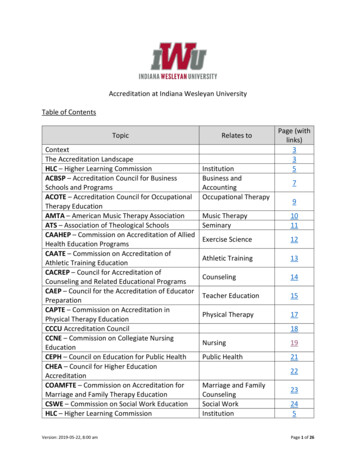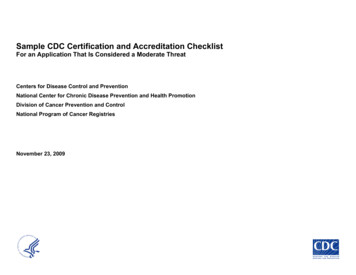
Transcription
Sample CDC Certification and Accreditation ChecklistFor an Application That Is Considered a Moderate ThreatCenters for Disease Control and PreventionNational Center for Chronic Disease Prevention and Health PromotionDivision of Cancer Prevention and ControlNational Program of Cancer RegistriesNovember 23, 2009
Moderate ControlNameControlNIST ControlSee Supplemental Guidance for More Detail of Each ControlAccess Control PolicyProceduresRegistryThe organization develops, disseminates, and periodically reviews/updates: (i) a formal,documented, access control policy that addresses purpose, scope, roles, responsibilities,management commitment, coordination among organizational entities, and compliance; and (ii)formal, documented procedures to facilitate the implementation of the access control policy andassociated access controls.Account ManagementRegistryThe organization manages information system accounts, including establishing, activating,modifying, reviewing, disabling, and removing accounts. The organization reviews informationsystem accounts at least annually.Control Enhancements:(1) The organization employs automated mechanisms to support the management of informationsystem accounts.(2) The information system automatically terminates temporary and emergency accounts after.organization-defined time period for each type of account.(3) The information system automatically disables inactive accounts after.organization-definedtime period.(4) The organization employs automated mechanisms to audit account creation, modification,disabling, and termination actions and to notify, as required, appropriate individuals.Response to AuditProcessing FailuresRegistryThe information system alerts appropriate organizational officials in the event of an auditprocessing failure and takes the following additional actions: [organization-defined actions to betaken (e.g., shut down information system, overwrite oldest audit records, stop generating auditrecords)].Information FlowEnforcementRegistryThe information system enforces assigned authorizations for controlling the flow of informationwithin the system and between interconnected systems in accordance with applicable policy.Separation of DutiesRegistryThe information system enforces separation of duties through assigned access authorizations.Time StampsRegistry The information system provides time stamps for use in audit record generation. Control/ Software Enhancements: (1) The organization synchronizes internal information system clocks[organization-defined frequency].User Identification andAuthenticationSoftware The information system uniquely identifies and authenticates users (or processes acting onbehalf of users). Related security controls: AC-14, AC-17. Control Enhancements: (1) Theinformation system employs multifactor authentication for remote system access that is NISTSpecial Publication 800-63 [Selection: organization-defined level 3, level 3 using a hardwareauthentication device, or level 4] compliant.Device Identificationand AuthenticationSoftware The information system identifies and authenticates specific devices before establishing aconnection.System Security PlanSoftware The organization develops and implements a security plan for the information system thatprovides an overview of the security requirements for the system and a description of thesecurity controls in place or planned for meeting those requirements.Sample CDC Certification and Accreditation Checklist for an Application That Is Considered a Moderate ThreatPage 2 of 18Method(s) Used toAddress NIST Control
Moderate ControlNameControlNIST ControlSee Supplemental Guidance for More Detail of Each ControlSession TerminationRegistryThe information system automatically terminates a remote session after [organization-definedtime period] of inactivity.Supervision andReview—AccessControlRegistryThe organization supervises and reviews the activities of users with respect to the enforcementand usage of information system access controls. The organization employs automatedmechanisms to facilitate the review of user activities.Permitted Actionswithout Identification orAuthenticationRegistryThe organization identifies and documents specific user actions that can be performed on theinformation system without identification or authentication. (1) The organization permits actionsto be performed without identification and authentication only to the extent necessary toaccomplish mission objectives. Related security control: IA-2.Remote AccessRegistryThe organization authorizes, monitors, and controls all methods of remote access to theinformation system. Related security control: IA-2.Control Enhancements: (1) The organization employs automated mechanisms to facilitate themonitoring and control of remote access methods. (2) The organization uses cryptography toprotect the confidentiality and integrity of remote access sessions. (3) The organization controlsall remote accesses through a limited number of managed access control points. (4) Theorganization permits remote access for privileged functions only for compelling operationalneeds and documents the rationale for such access in the security plan for the informationsystem.Wireless AccessRestrictionsRegistryThe organization: (i) establishes usage restrictions and implementation guidance for wirelesstechnologies; and (ii) authorizes, monitors, controls wireless access to the information system.Control Enhancements: (1) The organization uses authentication and encryption to protectwireless access to the information system.Access Control forPortable and MobileDevicesRegistryThe organization: (i) establishes usage restrictions and implementation guidance fororganization-controlled portable and mobile devices; and (ii) authorizes, monitors, and controlsdevice access to organizational information systems.Use of ExternalInformation SystemsRegistryThe organization establishes terms and conditions for authorized individuals to: (i) access theinformation system from an external information system; and (ii) process, store, and/or transmitorganization-controlled information using an external information system.Control Enhancements: (1) The organization prohibits authorized individuals from using anexternal information system to access the information system or to process, store, or transmitorganization-controlled information except in situations where the organization: (i) can verify theemployment of required security controls on the external system as specified in theorganization’s information security policy and system security plan; or (ii) has approvedinformation system connection or processing agreements with the organizational entity hostingthe external information system.Sample CDC Certification and Accreditation Checklist for an Application That Is Considered a Moderate ThreatPage 3 of 18Method(s) Used toAddress NIST Control
Moderate ControlNameControlNIST ControlSee Supplemental Guidance for More Detail of Each ControlSecurity Awarenessand Training Policy andProceduresRegistryThe organization develops, disseminates, and periodically reviews/updates: (i) a formal,documented, security awareness and training policy that addresses purpose, scope, roles,responsibilities, management commitment, coordination among organizational entities, andcompliance; and (ii) formal, documented procedures to facilitate the implementation of thesecurity awareness and training policy and associated security awareness and training controls.Security AwarenessRegistryThe organization provides basic security awareness training to all information system users(including managers and senior executives) before authorizing access to the system, whenrequired by system changes, and [Assignment: organization-defined frequency, at least annually]thereafter.Security TrainingRegistryThe organization identifies personnel that have significant information system security roles andresponsibilities during the system development life cycle, documents those roles andresponsibilities, and provides appropriate information system security training: (i) beforeauthorizing access to the system or performing assigned duties; (ii) when required by systemchanges; and (iii) [organization-defined frequency] thereafter.Security TrainingRecordsRegistryThe organization documents and monitors individual information system security trainingactivities including basic security awareness training and specific information system securitytraining.Audit andAccountability Policyand ProceduresRegistryThe organization develops, disseminates, and periodically reviews/updates: (i) a formal,documented, audit and accountability policy that addresses purpose, scope, roles,responsibilities, management commitment, coordination among organizational entities, andcompliance; and (ii) formal, documented procedures to facilitate the implementation of the auditand accountability policy and associated audit and accountability controls.System Security PlanUpdateSoftware The organization reviews the security plan for the information system [organization-definedfrequency, at least annually] and revises the plan to address system/organizational changes orproblems identified during plan implementation or security control assessments.Application PartitioningSoftware The information system separates user functionality (including user interface services) frominformation system management functionality.Audit Storage CapacityRegistryInformation RemnanceSoftware The information system prevents unauthorized and unintended information transfer via sharedsystem resources.Audit Monitoring,Analysis, andReportingRegistryThe organization allocates sufficient audit record storage capacity and configures auditing toreduce the likelihood of such capacity being exceeded. Related security controls: AU-2, AU-5,AU-6, AU-7, SI-4The organization regularly reviews/analyzes information system audit records for indications ofinappropriate or unusual activity, investigates suspicious activity or suspected violations, reportsfindings to appropriate officials, and takes necessary actions. Control Enhancements: (2) Theorganization employs automated mechanisms to alert security personnel of the followinginappropriate or unusual activities with security implications: [organization-defined list ofinappropriate or unusual activities that are to result in alerts]Sample CDC Certification and Accreditation Checklist for an Application That Is Considered a Moderate ThreatPage 4 of 18Method(s) Used toAddress NIST Control
Moderate ControlNameAudit Reduction andReport GenerationControlRegistryNIST ControlSee Supplemental Guidance for More Detail of Each ControlThe information system provides an audit reduction and report generation capability. ControlEnhancements: (1) The information system provides the capability to automatically process auditrecords for events of interest based upon selectable, event criteria.Information Accuracy,Software The information system checks information for accuracy, completeness, validity, and authenticityCompleteness, Validity,and AuthenticityProtection of AuditInformationRegistryThe information system protects audit information and audit tools from unauthorized access,modification, and deletion.Audit Record RetentionRegistryThe organization retains audit records for [Assignment: organization-defined time period] toprovide support for after-the-fact investigations of security incidents and to meet regulatory andorganizational information retention requirements.Certification,Accreditation, andSecurity AssessmentPolicies andProceduresRegistryThe organization develops, disseminates, and periodically reviews/updates: (i) formal,documented, security assessment and certification and accreditation policies that addresspurpose, scope, roles, responsibilities, management commitment, coordination amongorganizational entities, and compliance; and (ii) formal, documented procedures to facilitate theimplementation of the security assessment and certification and accreditation policies andassociated assessment, certification, and accreditation controls.Security AssessmentsRegistryThe organization conducts an assessment of the security controls in the information system[organization-defined frequency, at least annually] to determine the extent to which the controlsare implemented correctly, operating as intended, and producing the desired outcome withrespect to meeting the security requirements for the system.Information SystemConnectionsRegistryThe organization authorizes all connections from the information system to other informationsystems outside of the accreditation boundary through the use of system connection agreementsand monitors/controls the system connections on an ongoing basis.Security CertificationRegistryThe organization conducts an assessment of the security controls in the information system todetermine the extent to which the controls are implemented correctly, operating as intended, andproducing the desired outcome with respect to meeting the security requirements for the system.Related security controls: CA-2, CA-6, SA-11.Control Enhancements: (1) The organization employs an independent certification agent orcertification team to conduct an assessment of the security controls in the information system.Plan of Action andMilestonesRegistryThe organization develops and updates [Assignment: organization-defined frequency], a plan ofaction and milestones for the information system that documents the organization’s planned,implemented, and evaluated remedial actions to correct deficiencies noted during theassessment of the security controls and to reduce or eliminate known vulnerabilities in thesystem.Sample CDC Certification and Accreditation Checklist for an Application That Is Considered a Moderate ThreatPage 5 of 18Method(s) Used toAddress NIST Control
Moderate ControlNameControlSecurity AccreditationRegistryNIST ControlSee Supplemental Guidance for More Detail of Each ControlThe organization authorizes (i.e., accredits) the information system for processing beforeoperations and updates the authorization [Assignment: organization-defined frequency, at leastevery three years] or when there is a significant change to the system. A senior organizationalofficial signs and approves the security accreditation.Continuous MonitoringRegistryThe organization monitors the security controls in the information system on an ongoing basis.ConfigurationManagement Policyand ProceduresRegistryThe organization develops, disseminates, and periodically reviews/updates: (i) a formal,documented, configuration management policy that addresses purpose, scope, roles,responsibilities, management commitment, coordination among organizational entities, andcompliance; and (ii) formal, documented procedures to facilitate the implementation of theconfiguration management policy and associated configuration management controls.Baseline ConfigurationRegistryThe organization develops, documents, and maintains a current baseline configuration of theinformation system. Related security controls: CM-6, CM-8. Control Enhancements: (1) Theorganization updates the baseline configuration of the information system as an integral part ofinformation system component installations.Configuration ChangeControlRegistryThe organization authorizes, documents, and controls changes to the information system.MonitoringConfiguration ChangesRegistryThe organization monitors changes to the information system conducting security impactanalyses to determine the effects of the changes.Access Restrictions forChangeRegistryThe organization: (i) approves individual access privileges and enforces physical and logicalaccess restrictions associated with changes to the information system; and (ii) generates,retains, and reviews records reflecting all such changes.Configuration SettingsRegistryThe organization: (i) establishes mandatory configuration settings for information technologyproducts employed within the information system; (ii) configures the security settings ofinformation technology products to the most restrictive mode consistent with operationalrequirements; (iii) documents the configuration settings; and (iv) enforces the configurationsettings in all components of the information system.Least FunctionalityRegistryThe organization: (i) establishes mandatory configuration settings for information technologyproducts employed within the information system; (ii) configures the security settings ofinformation technology products to the most restrictive mode consistent with operationalrequirements; (iii) documents the configuration settings; and (iv) enforces the configurationsettings in all components of the information system.Information SystemComponent InventoryRegistryThe organization develops, documents, and maintains a current inventory of the components ofthe information system and relevant ownership information. Related security controls: CM-2, CM6. Control Enhancements: (1) The organization updates the inventory of information systemcomponents as an integral part of component installations.Sample CDC Certification and Accreditation Checklist for an Application That Is Considered a Moderate ThreatPage 6 of 18Method(s) Used toAddress NIST Control
Moderate ControlNameControlNIST ControlSee Supplemental Guidance for More Detail of Each ControlContingency PlanningPolicy and ProceduresRegistryThe organization develops, disseminates, and periodically reviews/updates: (i) a formal,documented, contingency planning policy that addresses purpose, scope, roles, responsibilities,management commitment, coordination among organizational entities, and compliance; and (ii)formal, documented procedures to facilitate the implementation of the contingency planningpolicy and associated contingency planning controls.Contingency PlanRegistryThe organization develops and implements a contingency plan for the information systemaddressing contingency roles, responsibilities, assigned individuals with contact information, andactivities associated with restoring the system after a disruption or failure. Designated officialswithin the organization review and approve the contingency plan and distribute copies of the planto key contingency personnel. Control Enhancements: (1) The organization coordinatescontingency plan development with organizational elements responsible for related plans.Enhancement Supplemental Guidance: Examples of related plans include Business ContinuityPlan, Disaster Recovery Plan, Continuity of Operations Plan, Business Recovery Plan, IncidentResponse Plan, and Emergency Action Plan.Contingency TrainingRegistryThe organization trains personnel in their contingency roles and responsibilities with respect tothe information system and provides refresher training [Assignment: organization-definedfrequency, at least annually].Contingency PlanTesting and ExercisesRegistryThe organization: (i) tests and/or exercises the contingency plan for the information system[Assignment: organization-defined frequency, at least annually] using [Assignment: organizationdefined tests and/or exercises] to determine the plan’s effectiveness and the organization’sreadiness to execute the plan; and (ii) reviews the contingency plan test/exercise results andinitiates corrective actions. Control Enhancements: (1) The organization coordinates contingencyplan testing and/or exercises with organizational elements responsible for related plans.Contingency PlanUpdateRegistryThe organization reviews the contingency plan for the information system [Assignment:organization-defined frequency, at least annually] and revises the plan to addresssystem/organizational changes or problems encountered during plan implementation, execution,or testing.Alternate Storage SiteRegistryThe organization identifies an alternate storage site and initiates necessary agreements to permitthe storage of information system backup information. Control Enhancements: (1) Theorganization identifies an alternate storage site that is geographically separated from the primarystorage site so as not to be susceptible to the same hazards. (3) The organization identifiespotential accessibility problems to the alternate storage site in the event of an area-widedisruption or disaster and outlines explicit mitigation actions.Sample CDC Certification and Accreditation Checklist for an Application That Is Considered a Moderate ThreatPage 7 of 18Method(s) Used toAddress NIST Control
Moderate ControlNameControlNIST ControlSee Supplemental Guidance for More Detail of Each ControlAlternate ProcessingSiteRegistryTo permit the resumption of information system operations for critical mission/business functionswithin [Assignment: organization-defined time period] when the primary processing capabilitiesare unavailable. Control Enhancements: (1) The organization identifies an alternate processingsite that is geographically separated from the primary processing site so as not to be susceptibleto the same hazards. (2) The organization identifies potential accessibility problems to thealternate processing site in the event of an area-wide disruption or disaster and outlines explicitmitigation actions. (3) The organization develops alternate processing site agreements thatcontain priority-of-service provisions in accordance with the organization’s sRegistryThe organization identifies primary and alternate telecommunications services to support theinformation system and initiates necessary agreements to permit the resumption of systemoperations for critical mission/business functions within [Assignment: organization-defined timeperiod] when the primary telecommunications capabilities are unavailable. ControlEnhancements: (1) The organization develops primary and alternate telecommunications serviceagreements that contain priority-of-service provisions in accordance with the organization’savailability requirements. (2) The organization obtains alternate telecommunications servicesthat do not share a single point of failure with primary telecommunications services.Information SystemBackupRegistryThe organization conducts backups of user-level and system-level information (including systemstate information) contained in the information system [organization-defined frequency] andprotects backup information at the storage location. Related security controls: MP-4, MP-5.Control Enhancements: (1) The organization tests backup information [organization-definedfrequency] to verify media reliability and information integrity. (4) The organization protectssystem backup information from unauthorized modification.Information SystemRecovery andReconstitutionRegistryThe organization employs mechanisms with supporting procedures to allow the informationsystem to be recovered and reconstituted to a known secure state after a disruption or failure.Error HandlingSoftware The information system identifies and handles error conditions in an expeditious manner withoutproviding information that could be exploited by adversaries.Information SystemDocumentationSoftware The organization obtains, protects as required, and makes available to authorized personnel,adequate documentation for the information system. Control Enhancements:(1) The organization includes, in addition to administrator and user guides, documentation, ifavailable from the vendor/manufacturer, describing the functional properties of the securitycontrols employed within the information system with sufficient detail to permit analysis andtesting of the controlsAuditable EventsRegistry The information system generates audit records for the following events: [organization-defined/ Software auditable events]. Control Enhancements: (3) The organization periodically reviews and updatesthe list of organization-defined auditable events.Sample CDC Certification and Accreditation Checklist for an Application That Is Considered a Moderate ThreatPage 8 of 18Method(s) Used toAddress NIST Control
Moderate ControlNameControlNIST ControlSee Supplemental Guidance for More Detail of Each ControlIdentifier ManagementRegistryThe organization manages user identifiers by: (i) uniquely identifying each user; (ii) verifying theidentity of each user; (iii) receiving authorization to issue a user identifier from an appropriateorganization official; (iv) issuing the user identifier to the intended party; (v) disabling the useridentifier after [Assignment: organization-defined time period] of inactivity; and (vi) archiving useridentifiers.AuthenticatorManagementRegistryThe organization manages information system authenticators by: (i) defining initial authenticatorcontent; (ii) establishing administrative procedures for initial authenticator distribution, forlost/compromised, or damaged authenticators, and for revoking authenticators; (iii) changingdefault authenticators upon information system installation; and (iv) changing/refreshingauthenticators periodically.AuthenticatorFeedbackRegistryThe information system obscures feedback of authentication information during theauthentication process to protect the information from possible exploitation/use by unauthorizedindividuals.Cryptographic ModuleAuthenticationRegistryThe information system employs authentication methods that meet the requirements ofapplicable laws, Executive Orders, directives, policies, regulations, standards, and guidance forauthentication to a cryptographic module.Incident ResponsePolicy and ProceduresRegistryThe organization develops, disseminates, and periodically reviews/updates: (i) a formal,documented, incident response policy that addresses purpose, scope, roles, responsibilities,management commitment, coordination among organizational entities, and compliance; and (ii)formal, documented procedures to facilitate the implementation of the incident response policyand associated incident response controls.Incident ResponseTrainingRegistryThe organization trains personnel in their incident response roles and responsibilities withrespect to the information system and provides refresher training [Assignment: organizationdefined frequency, at least annually].Incident ResponseTesting and ExercisesRegistryThe organization tests and/or exercises the incident response capability for the informationsystem [Assignment: organization-defined frequency, at least annually] using [Assignment:organization-defined tests and/or exercises] to determine the incident response effectivenessand documents the results.Incident HandlingRegistryThe organization implements an incident handling capability for security incidents that includespreparation, detection and analysis, containment, eradication, and recovery. Related securitycontrols: AU-6, PE-6. Control Enhancements: (1) The organization employs automatedmechanisms to support the incident handling process.Incident MonitoringRegistryThe organization tracks and documents information system security incidents on an ongoingbasis.Incident ReportingRegistryThe organization promptly reports incident information to appropriate authorities.Sample CDC Certification and Accreditation Checklist for an Application That Is Considered a Moderate ThreatPage 9 of 18Method(s) Used toAddress NIST Control
Moderate ControlNameControlNIST ControlSee Supplemental Guidance for More Detail of Each ControlIncident ResponseAssistanceRegistryThe organization provides an incident response support resource that offers advice andassistance to users of the information system for the handling and reporting of security incidents.The support resource is an integral part of the organization’s incident response capability.Control Enhancements: (1) The organization employs automated mechanisms to increase theavailability of incident response-related information and support.System MaintenancePolicy and ProceduresRegistryThe organization develops, disseminates, and periodically reviews/updates: (i) a formal,documented, information system maintenance policy that addresses purpose, scope, roles,responsibilities, management commitment, coordination among organizational entities, andcompliance; and (ii) formal, documented procedures to facilitate the implementation of theinformation system maintenance policy and associated system maintenance controls.ControlledMaintenanceRegistryThe organization schedules, performs, documents, and reviews records of routine preventativeand regular maintenance (including repairs) on the components of the information system inaccordance with manufacturer or vendor specifications and/or organizational requirements.Control Enhancements: The organization maintains maintenance records for the informationsystem that include: (i) the date and time of maintenance; (ii) name of the individual performingthe maintenance; (iii) name of escort, if necessary; (iv) a description of the maintenanceperformed; and (v) a list of equipment removed or replaced (including identification numbers, ifapplicable).Maintenance ToolsRegistryThe organization approves, controls, and monitors the use of information system maintenancetools and maintains the tools on an ongoing basis.Remote MaintenanceRegistryThe organization authorizes, monitors, and controls any remotely executed maintenance anddiagnostic activities, if employed. Control Enhancements: (1) The organization audits all remotemaintenance and diagnostic sessions and appropriate organizational personnel review themaintenance records of the remote sessions. (2) The organization addresses the installation anduse of remote maintenance and diagnostic links in the security plan for the information system.Maintenance PersonnelRegistryThe organization allows only authorized personnel to perform maintenance on the informationsystem.Timely MaintenanceRegistryThe organization obtains maintenance support and spare parts for [organization-defined list ofkey information system components]
documented, audit and accountability policy that addresses purpose, scope, roles, responsibilities, management commitment, coordination among organizational entities, and compliance; and (ii) formal, documented procedures to facilitate the implementation of the audit and accountability policy and associated audit and accountability controls.

